Heat Budget of Sub-Mediterranean Downy Oak Landscapes of Southeastern Crimea
Abstract
:1. Introduction
2. Materials and Methods
2.1. Study Area
2.2. Research Methodology
3. Results
3.1. Study Site: Open Area within the Downy Oak Forest Zone
3.1.1. Radiation Balance Analysis
3.1.2. Evaporation Heat Expenditure
3.1.3. Turbulent Heat Flux
3.1.4. Soil Heat Flux
3.2. Study Site: Downy Oak Forest Zone
3.2.1. Radiation Balance
3.2.2. Evaporation Heat Expenditure
3.2.3. Turbulent Heat Flux
3.2.4. Turbulent Heat Flux
3.3. Air Temperature Relationship with Primary Heat Balance Elements
4. Discussion
5. Conclusions
Author Contributions
Funding
Data Availability Statement
Conflicts of Interest
References
- Budyko, M.I. Energy Budget of the Earth’s Surface; Gidrometeoizdat: Leningrad, Russia, 1956; 286p. [Google Scholar]
- Ippolitov, I.I.; Kabanov, M.V.; Loginov, S.V.; Sokolov, K.I.; Kharyutkina, E.V. Variability of components of the surface thermal balance at the Asian Russia area during the current global warming. Opt. Atmos. Okeana 2011, 24, 22–29. [Google Scholar]
- Brunt, D. Notes on radiation in the atmosphere. I. Q. J. R. Meteorol. Soc. 1932, 58, 389–420. [Google Scholar] [CrossRef]
- Christen, A.; Novak, M.D.; Black, A.T.; Brown, M. The Budget of Turbulent Kinetic Energy within and Above a Sparse Lodgepole Pine Stand. Available online: https://www.researchgate.net/publication/51995947_The_budget_of_turbulent_kinetic_energy_within_and_above_a_sparse_Lodgepole_Pine_stand (accessed on 8 August 2023).
- Njuki, S.M.; Mannaerts, C.M.; Su, Z. Accounting for Turbulence-Induced Canopy Heat Transfer in the Simulation of Sensible Heat Flux in SEBS Model. Remote Sens. 2023, 15, 1578. [Google Scholar] [CrossRef]
- Vecellio, D.J.; Wolf, S.T.; Cottle, R.M.; Kenney, W.L. Utility of the Heat Index in defining the upper limits of thermal balance during light physical activity (PSU HEAT Project). Int. J. Biometeorol. 2022, 66, 1759–1769. [Google Scholar] [CrossRef]
- Wang, J.; Buttar, N.A.; Hu, Y.; Lakhiar, I.A.; Javed, Q.; Shabbir, A. Estimation of Sensible and Latent Heat Fluxes Using Surface Renewal Method: Case Study of a Tea Plantation. Agronomy 2021, 11, 179. [Google Scholar] [CrossRef]
- Fuchs, S.; Beardsmore, G.; Chiozzi, P.; Espinoza-Ojeda, O.M.; Gola, G.; Gosnold, W.; Harris, R.; Jennings, S.; Liu, S.; Negrete-Aranda, R.; et al. A new database structure for the IHFC Global Heat Flow Database. Int. J. Terr. Heat Flow Appl. 2021, 4, 1–14. [Google Scholar] [CrossRef]
- Bhattacharya, B.K.; Mallick, K.; Desai, D.; Bhat, G.S.; Morrison, R.; Clevery, J.R.; Woodgate, W.; Beringer, J.; Cawse-Nicholson, K.; Ma, S.; et al. A coupled ground heat flux–surface energy balance model of evaporation using thermal remote sensing observations. Biogeosciences 2022, 19, 5521–5551. [Google Scholar] [CrossRef]
- Ander, T. Earth’s Balanced Climates in View of Their Energy Budgets. Available online: https://doi.org/10.21203/rs.3.rs-568771/v1 (accessed on 8 August 2023).
- Liang, S.; Wang, D.; He, T.; Yu, Y. Remote sensing of earth’s energy budget: Synthesis and review. Int. J. Digit. Earth 2018, 12, 737–780. [Google Scholar] [CrossRef]
- Voeykov, V.A. Klimaty Zemnogo Shara, v Osobennosti Rossii [Climates of the Globe, Especially Russia]; A. Ilyin: St. Petersburg, FL, USA, 1884. [Google Scholar]
- Berlyand, T.G. Radiation and heat balance of the European territory of the USSR. Proc. Voeikov Main Geophys. Obs. 1948, 10, 72. [Google Scholar]
- Alestalo, M. The energy budget of the earth–atmosphere system in Europe. Tellus A Dyn. Meteorol. Oceanogr. 1981, 33, 360. [Google Scholar] [CrossRef]
- Killeen, T.; Burns, A.; Azeem, I.; Cochran, S.; Roble, R. A theoretical analysis of the energy budget in the lower thermosphere. J. Atmos. Solar Terr. Phys. 1997, 59, 675–689. [Google Scholar] [CrossRef]
- Mannstein, H. Surface Energy Budget, Surface Temperature and Thermal Inertia. In Remote Sensing Applications in Meteorology and Climatology; Springer: Dordrecht, The Netherlands, 1987; pp. 391–410. [Google Scholar] [CrossRef]
- Zeman, O.; Tennekes, H. Parameterization of the Turbulent Energy Budget at the Top of the Daytime Atmospheric Boundary Layer. J. Atmos. Sci. 1977, 34, 111–123. [Google Scholar] [CrossRef]
- Pavlov, A.V. Thermal Physics of Landscapes Science; Nayka: Novosibirsk, Russia, 1979; 284p. [Google Scholar]
- Isakov, A.L.; Lavrova, A.Y. Solar radiation and temperature regime of the roadbed. Path Track Manag. 2016, 3, 15–19. [Google Scholar]
- Prokhorova, U.; Terekhov, A.; Ivanov, B.; Verkulich, S. Calculation of the Heat Balance Components of the Aldegonda Glacier (Western Spitsbergen) During the Ablation Period according to the Observations of 2019. Kriosf. Zemli 2021, 25, 50–60. [Google Scholar] [CrossRef]
- Trenberth, K.E.; Fasullo, J.T.; Kiehl, J. Earth’s Global Energy Budget. Bull. Am. Meteorol. Soc. 2009, 90, 311–324. [Google Scholar] [CrossRef]
- Kiehl, J.T.; Trenberth, K.E. Earth’s Annual Global Mean Energy Budget. Bull. Am. Meteorol. Soc. 1997, 78, 197–208. [Google Scholar] [CrossRef]
- Loeb, N.G.; Wielicki, B.A.; Doelling, D.R.; Smith, G.L.; Keyes, D.F.; Kato, S.; Manalo-Smith, N.; Wong, T. Toward Optimal Closure of the Earth’s Top-of-Atmosphere Radiation Budget. J. Clim. 2009, 22, 748–766. [Google Scholar] [CrossRef]
- Wang, Q.; Zhang, H.; Yang, S.; Chen, Q.; Zhou, X.; Xie, B.; Wang, Y.; Shi, G.; Wild, M. An assessment of land energy balance over East Asia from multiple lines of evidence and the roles of the Tibet Plateau, aerosols, and clouds. Atmos. Meas. Tech. 2022, 22, 15867–15886. [Google Scholar] [CrossRef]
- Savijärvi, H. The atmospheric energy budgets over North America, the North Atlantic and Europe based on ECMWF analyses and forecasts. Tellus A Dyn. Meteorol. Oceanogr. 1983, 35, 39. [Google Scholar] [CrossRef]
- Shongwe, M.E.; Graversen, R.G.; van Oldenborgh, G.J.; van der Hurk, B.J.J.M.; Doblas-Reyes, F.J. Energy budget of the extreme Autumn 2006 in Europe. Clim. Dyn. 2009, 36, 1055–1066. [Google Scholar] [CrossRef]
- Hagemann, S.; Machenhauer, B.; Jones, R.; Christensen, O.B.; Jacob, D.; Vidale, P.L.; Déqué, M. Evaluation of water and energy budgets in regional climate models applied over Europe. Clim. Dyn. 2004, 23, 547–567. [Google Scholar] [CrossRef]
- Partington, J.R. An Advanced Treatise on Physical Chemistry. Available online: https://archive.org/details/advancedtreatise0003jrpa/page/n5/mode/2up (accessed on 8 August 2023).
- Prigogine, I.; Defay, R. Chemical Thermodynamics; Longmans, Green & Co.: London, UK, 1954. [Google Scholar]
- Adkins, C.J. Balance Thermodynamics. Available online: https://archive.org/details/equilibriumtherm0000adki (accessed on 8 August 2023).
- Landsberg, P.T. Thermodynamics and Statistical Mechanics; Oxford University Press: Oxford, UK, 1978; p. 11. [Google Scholar]
- Gerasimov, Y.I. (Ed.) Course of Physical Chemistry; Khimia: Moscow, Russia, 1969. [Google Scholar]
- Perrot, P. A to Z of Thermodynamics; Oxford University Press: Oxford, UK, 1998. [Google Scholar]
- Clark, J.O.E. The Essential Dictionary of Science. Available online: https://archive.org/details/essentialdiction0000unse (accessed on 8 August 2023).
- Haag, R.W.; Bliss, L.C. Functional Effects of Vegetation on the Radiant Energy Budget of Boreal Forest. Can. Geotech. J. 1974, 11, 374–379. [Google Scholar] [CrossRef]
- Surova, N.A. Productivity and Heat Balance of Boreal Forests in South-Kuril Islands. Samara Luka 2018, 27, 147–160. [Google Scholar]
- Bityukov, N.A. Heat Exchange and Heat Balance of Brown Forest Soils under Beech Tree Forest. Bull. Sochi State Univ. 2012, 3, 224–230. [Google Scholar]
- Akimova, D.P. Radiation and thermal regimes in oak-pine crops at an altitude of 1300 m and in the field of nutrition of mineral sources. Sci. Work. All Russ. Sci. Res. Inst. For. For. Mech. 1972, 11, 3–11. [Google Scholar]
- Alekseev, V.A. Light Mode of the Forest; Gidrometeoizdat: Leningrad, Russia, 1975; 227p. [Google Scholar]
- Vygodskaya, N.N. Radiation regime of 30-year-old oak forest in daily and seasonal dynamics. In Light Regime, Photosynthesis and Forest Productivity; Nauka: Moscow, Russia, 1967; pp. 77–94. [Google Scholar]
- Vygodskaya, N.N. Methodology of phytoactinometric studies in mountainous areas. In Phytoactinometric Studies of Mountain Forests; USSR Academy of Sciences: Vladivostok, Russia, 1977; pp. 20–37. [Google Scholar]
- Zukert, N.V.; Vygodskaya, N.N.; Lebedeva, M.G.; Sherman, E.V. Radiation regime under the canopy of mountain forests. In Phytoactinometric Studies of Mountain Forests; USSR Academy of Sciences: Vladivostok, Russia, 1967; pp. 162–178. [Google Scholar]
- Ugarov, I.S. The radiation budget of a forest in Central Yakutia. Sci. Alm. 2018, 9, 128–133. [Google Scholar]
- Stewart, J.; Thom, A. Energy budgets in pine forest. Q. J. R. Meteorol. Soc. 1973, 99, 154–170. [Google Scholar] [CrossRef]
- Thom, A.; Stewart, J.; Oliver, H.; Gash, J. Comparison of aerodynamic and energy budget estimates of fluxes over a pine forest. Q. J. R. Meteorol. Soc. 1975, 101, 93–105. [Google Scholar] [CrossRef]
- Nousu, J.P.; Lafaysse, M.; Mazzotti, G.; Ala-aho, P.; Marttila, H.; Cluzet, B.; Aurela, M.; Lohila, A.; Kolari, P.; Boone, A.; et al. Modelling snowpack dynamics and surface energy budget in boreal and subarctic peatlands and forests. EGUsphere 2023, 2023, 1–52. [Google Scholar]
- Reimer, A.; Desmarais, R. Micrometeorological energy budget methods and apparent diffusivity for Boreal forest and grass sites at Pinawa, Manitoba, Canada. Agric. Meteorol. 1973, 11, 419–436. [Google Scholar] [CrossRef]
- Constantin, J.; Inclan, M.; Raschendorfer, M. The energy budget of a spruce forest: Field measurements and comparison with the forest–land–atmosphere model (FLAME). J. Hydrol. 1998, 212–213, 22–35. [Google Scholar] [CrossRef]
- Wu, J.; Guan, D.; Han, S.; Shi, T.; Jin, C.; Pei, T.; Yu, G. Energy budget above a temperate mixed forest in northeastern China. Hydrol. Process. 2006, 21, 2425–2434. [Google Scholar] [CrossRef]
- Lindroth, A.; Iritz, Z. Surface energy budget dynamics of short-rotation willow forest. Theor. Appl. Clim. 1993, 47, 175–185. [Google Scholar] [CrossRef]
- Storr, D.; Tomlain, J.; Cork, H.F.; Munn, R.E. An Energy Budget Study Above the Forest Canopy at Marmot Creek, Alberta, 1967. Water Resour. Res. 1970, 6, 705–716. [Google Scholar] [CrossRef]
- Tunick, A. A radiation and energy budget algorithm for forest canopies. Meteorol. Atmos. Phys. 2005, 91, 237–246. [Google Scholar] [CrossRef]
- Vourlitis, G.L.; Nogueira, J.D.S.; Lobo, F.D.A.; Sendall, K.M.; de Paulo, S.R.; Dias, C.A.A.; Pinto, O.B.; de Andrade, N.L.R. Energy balance and canopy conductance of a tropical semi-deciduous forest of the southern Amazon Basin. Water Resour. Res. 2008, 44, W03412. [Google Scholar] [CrossRef]
- Ohta, T.; Hashimoto, T.; Ishibashi, H. Energy budget comparison of snowmelt rates in a deciduous forest and an open site. Ann. Glaciol. 1993, 18, 53–59. [Google Scholar] [CrossRef]
- Ved’, I.P. Peculiarities of energy budget and radiation balance of pine plantations under frost conditions. Izv. USSR Acad. Sci. Geogr. 1969, 4, 109–113. [Google Scholar]
- Ved’, I.P. The Radiation Balance and the Phytoclimate of Young Stands of Pinus Pallasiana Lamb. Lesovedeniye 1974, 5, 3–9. [Google Scholar]
- Ved’, I.P. Energy budget and radiation balance of the forest in the Crimean Highlands. Izv. USSR Acad. Sci. Geogr. 1971, 2, 61–70. [Google Scholar]
- Bokov, V.A. (Ed.) Landscape and Geophysical Conditions for the Growth of Forests in the Southeastern Part of the Mountainous Crimea; Tavria-Plus: Simferopol, Ukraine, 2001. [Google Scholar]
- Li, Z.; Deng, X.; Shi, Q.; Ke, X.; Liu, Y. Modeling the Impacts of Boreal Deforestation on the Near-Surface Temperature in European Russia. Adv. Meteorol. 2013, 2013, 486962. [Google Scholar] [CrossRef]
- Gorbunov, R.; Tabunshchik, V.; Gorbunova, T.; Safonova, M. Water Balance Components of Sub-Mediterranean Downy Oak Landscapes of Southeastern Crimea. Forests 2022, 13, 1370. [Google Scholar] [CrossRef]
- Rakhmanov, V.V. The Hydroclimatic Role of Forests; Lesnaya Promyshlennost’: Moscow, Russia, 1984; 240p. [Google Scholar]
- Berlyand, M.E. Prediction and Regulation of the Thermal Regime of the Surface Layer of the Atmosphere; Gidrometeoizdat: Leningrad, Russia, 1956; 435p. [Google Scholar]
- Air Density, Its Specific Heat Capacity, Viscosity and Other Physical Properties. Available online: http://thermalinfo.ru/svojstva-gazov/gazovye-smesi/fizicheskie-svojstva-vozduha-plotnost-vyazkost-teploemkost-entropiya (accessed on 8 August 2023).
- Makarychev, S.V.; Mazirov, M.A. Thermophysical Foundations of Soil Reclamation; All-Russian Scientific Research Institute of Agrochemistry named after D.N. Pryanishnikov: Moscow, Russia, 2004; 290p. [Google Scholar]
- Makarychev, S.V. The Ability to Determine the Dimensional Heat Capacity of Soils. RU Patent No. 4914260, 20 November 1993. 4p. [Google Scholar]
- Gorbunov, R.V.; Gorbunova, T.Y.u.; Kuznetsov, A.N.; Kuznetsova, S.P.; Lebedev Ya, O.; Nguen, D.H.; Vu, M. Peculiarities of Formation of Radiation Balance Elements in the Mid-Mountain Tropical Forests of Southern Vietnam. Proc. T.I.Vyazemsky Karadag Sci. Stn. Nat. Reserve Russ. Acad. Sci. USA 2019, 4, 3–16. [Google Scholar] [CrossRef]
- Muñoz Sabater, J. ERA5-Land Monthly Averaged Data from 1981 to Present. Copernicus Climate Change Service (C3S) Climate Data Store (CDS). Available online: https://cds.climate.copernicus.eu/cdsapp#!/dataset/10.24381/cds.68d2bb30?tab=overview (accessed on 8 August 2023).
- Wang, Y.; Zhao, X.; Mamtimin, A.; Sayit, H.; Abulizi, S.; Maturdi, A.; Yang, F.; Huo, W.; Zhou, C.; Yang, X.; et al. Evaluation of Reanalysis Datasets for Solar Radiation with In Situ Observations at a Location over the Gobi Region of Xinjiang, China. Remote Sens. 2021, 13, 4191. [Google Scholar] [CrossRef]
- Jiang, H.; Yang, Y.; Wang, H.; Bai, Y.; Bai, Y. Surface Diffuse Solar Radiation Determined by Reanalysis and Satellite over East Asia: Evaluation and Comparison. Remote Sens. 2020, 12, 1387. [Google Scholar] [CrossRef]
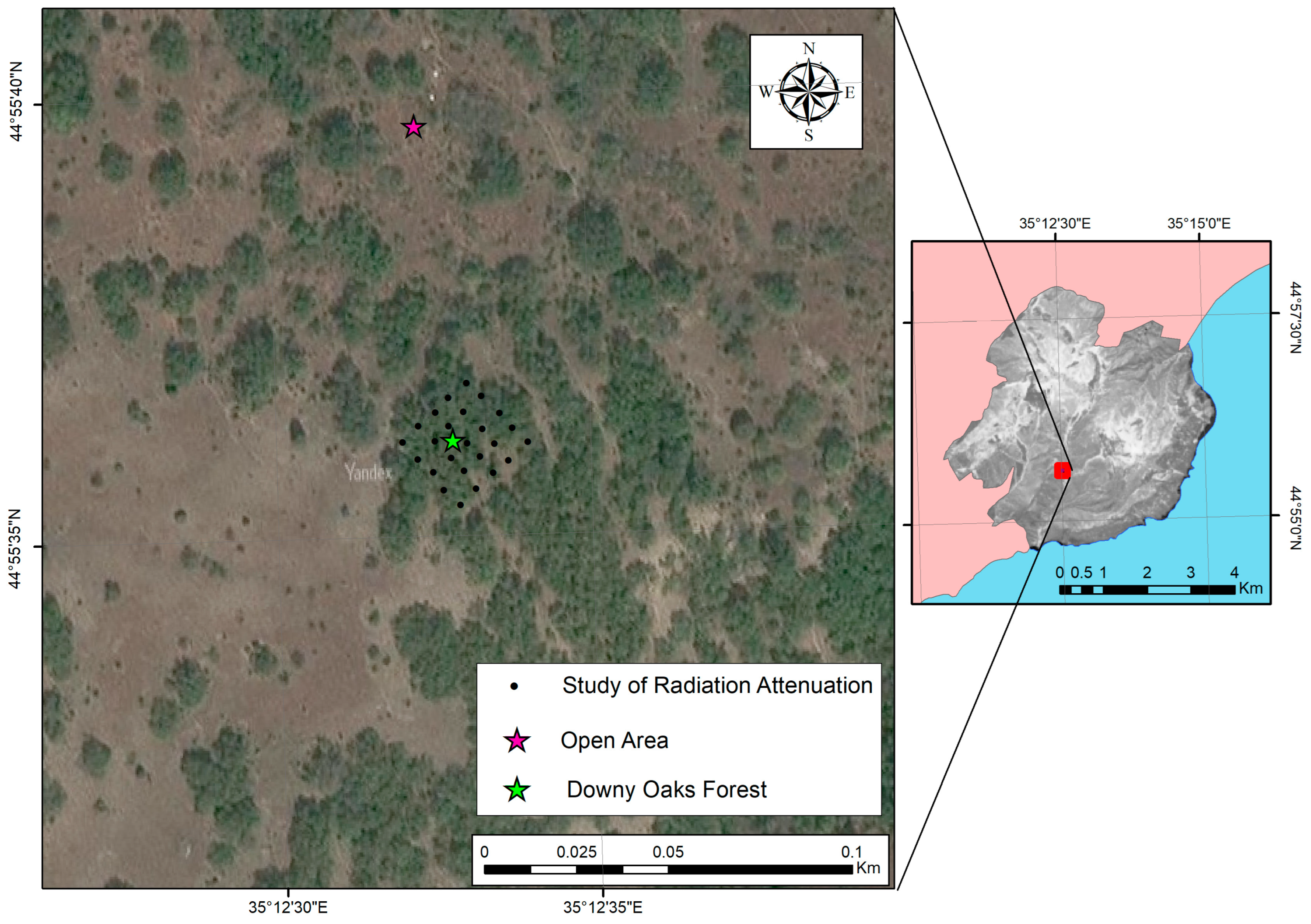

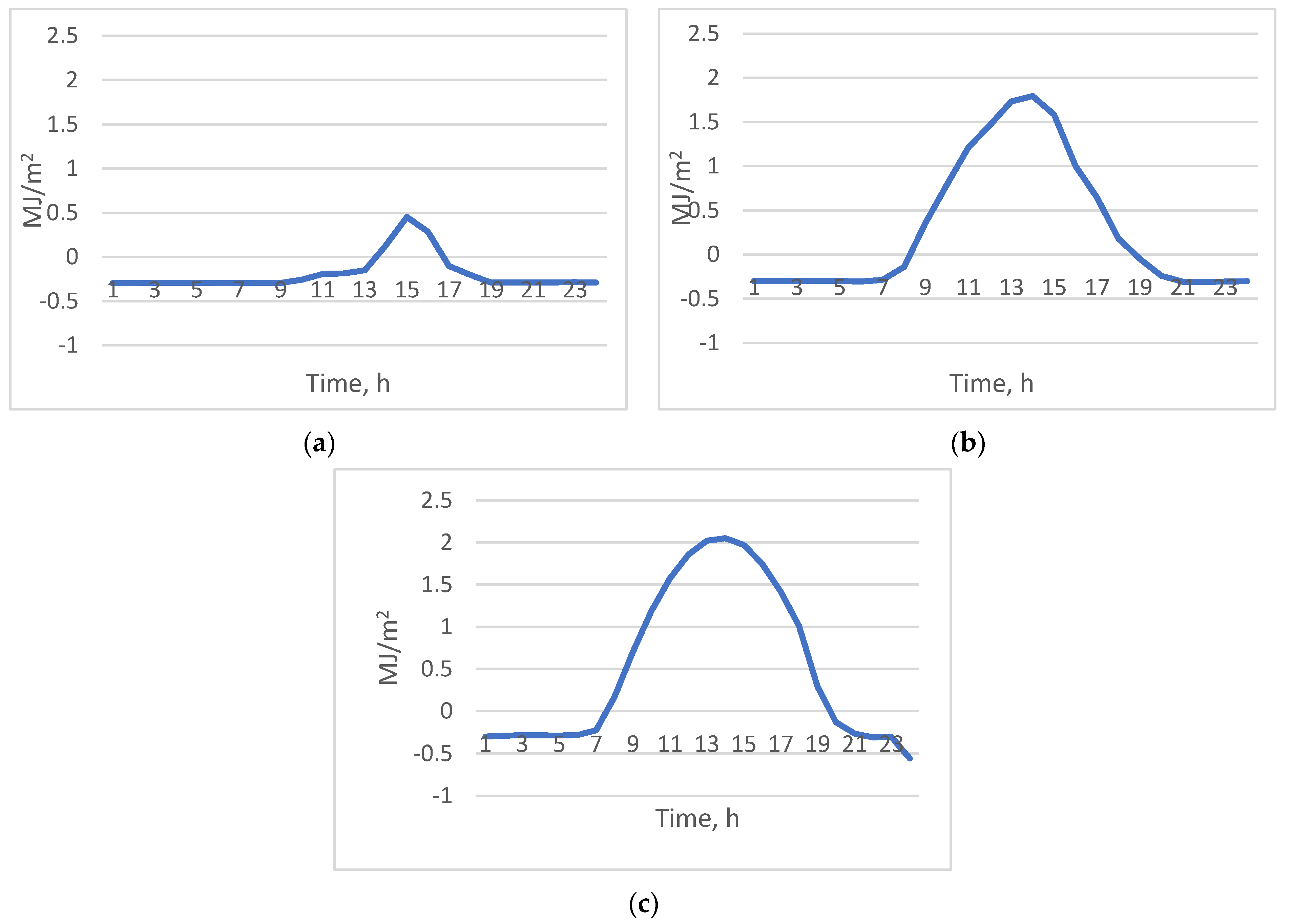



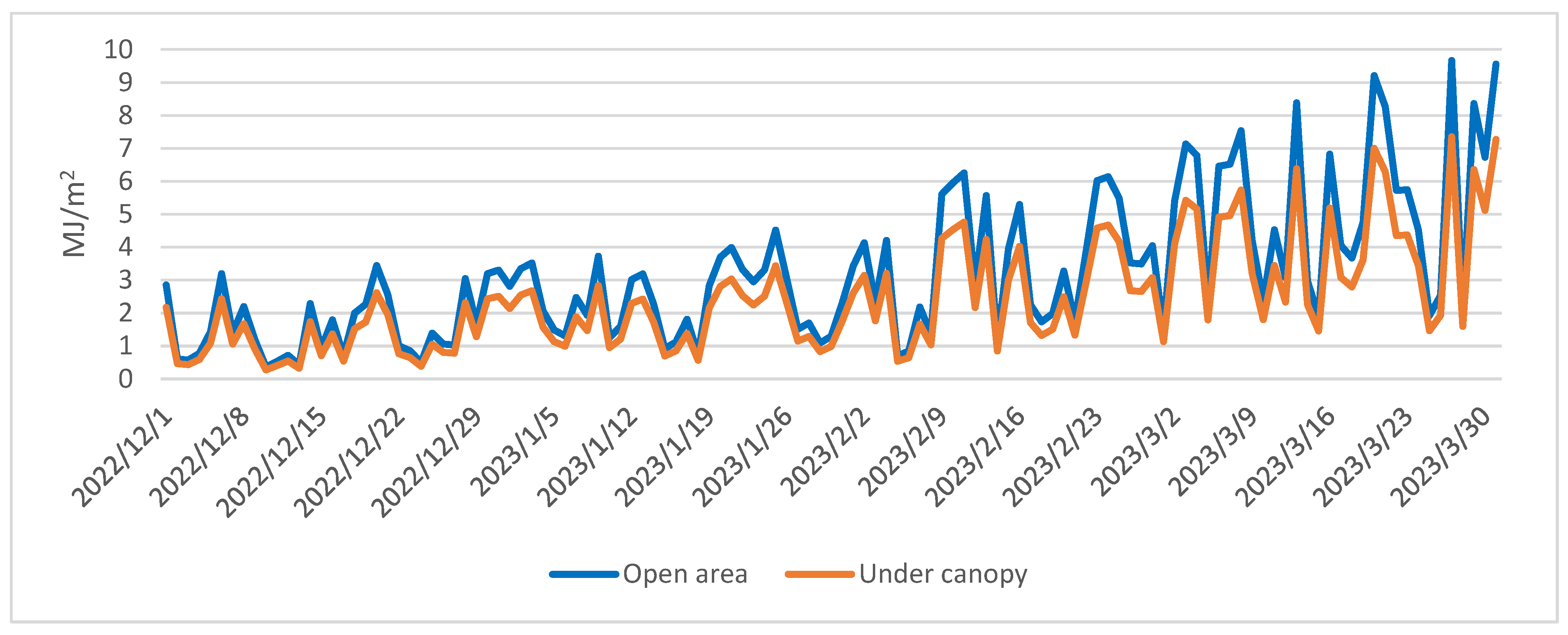

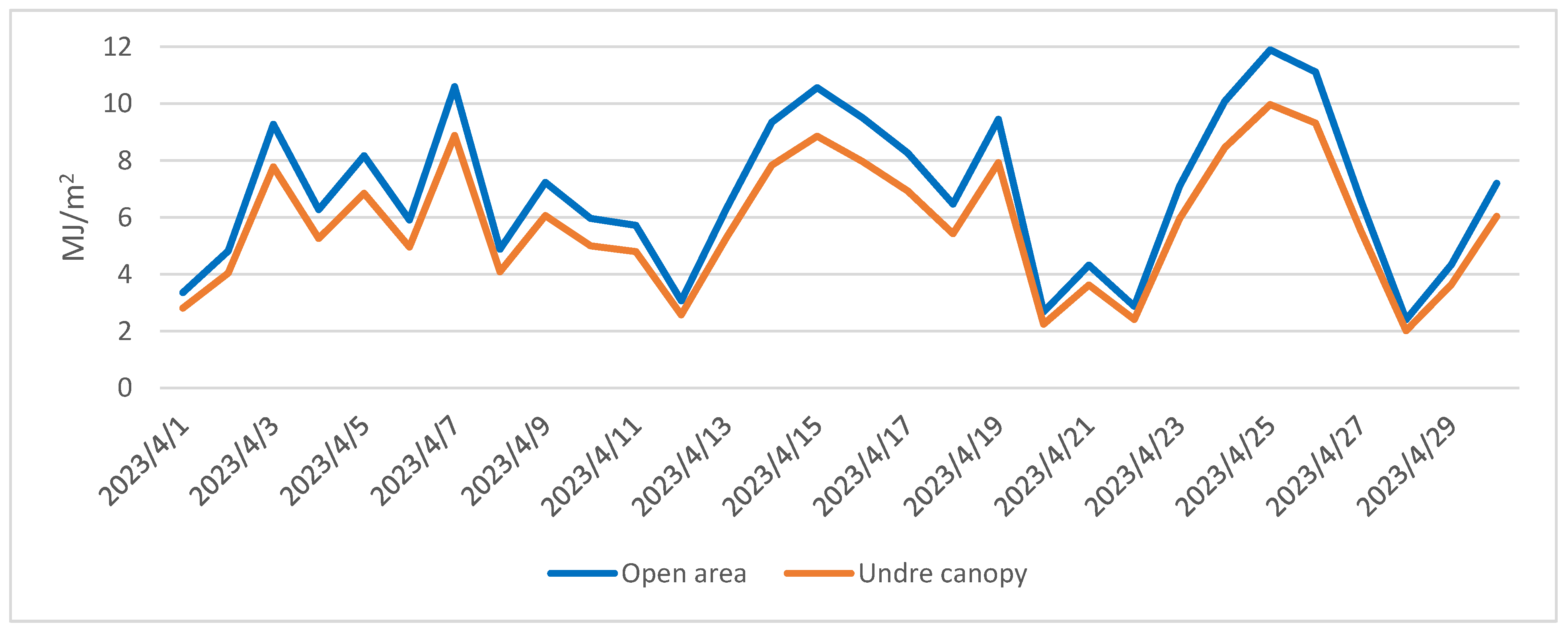
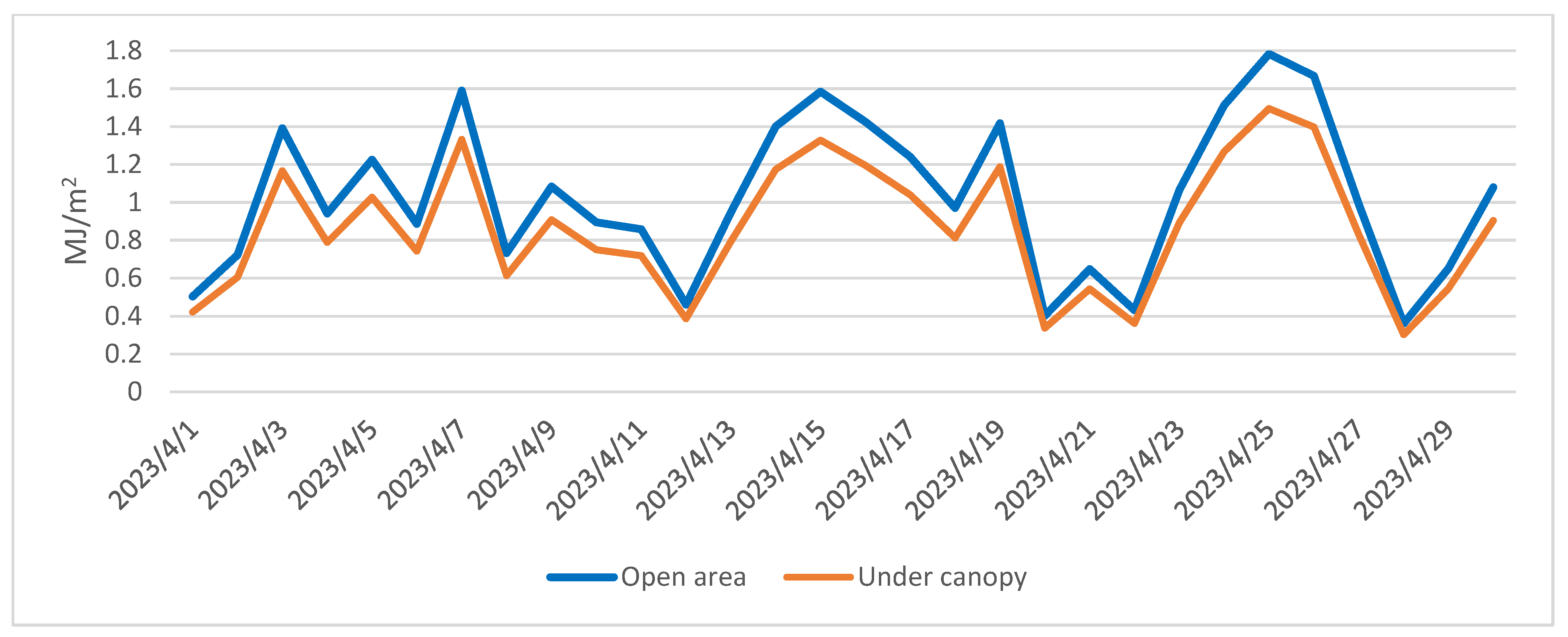
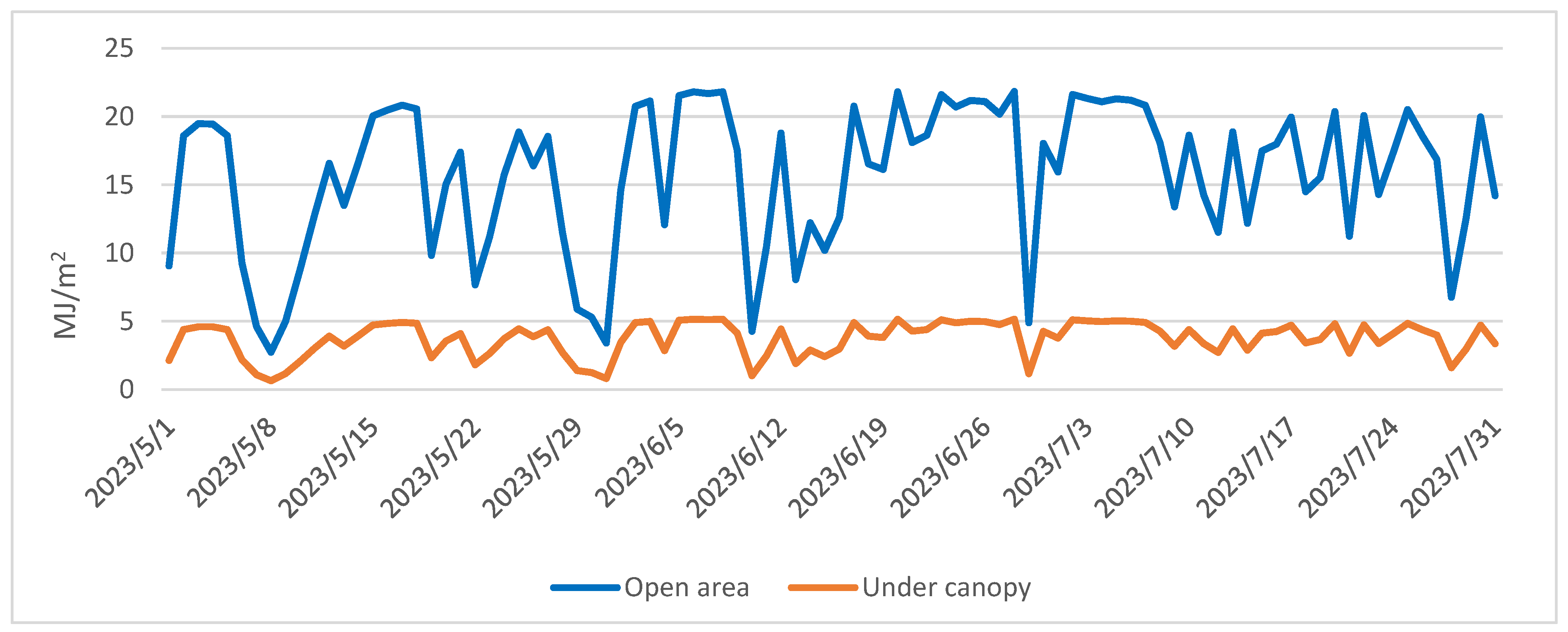
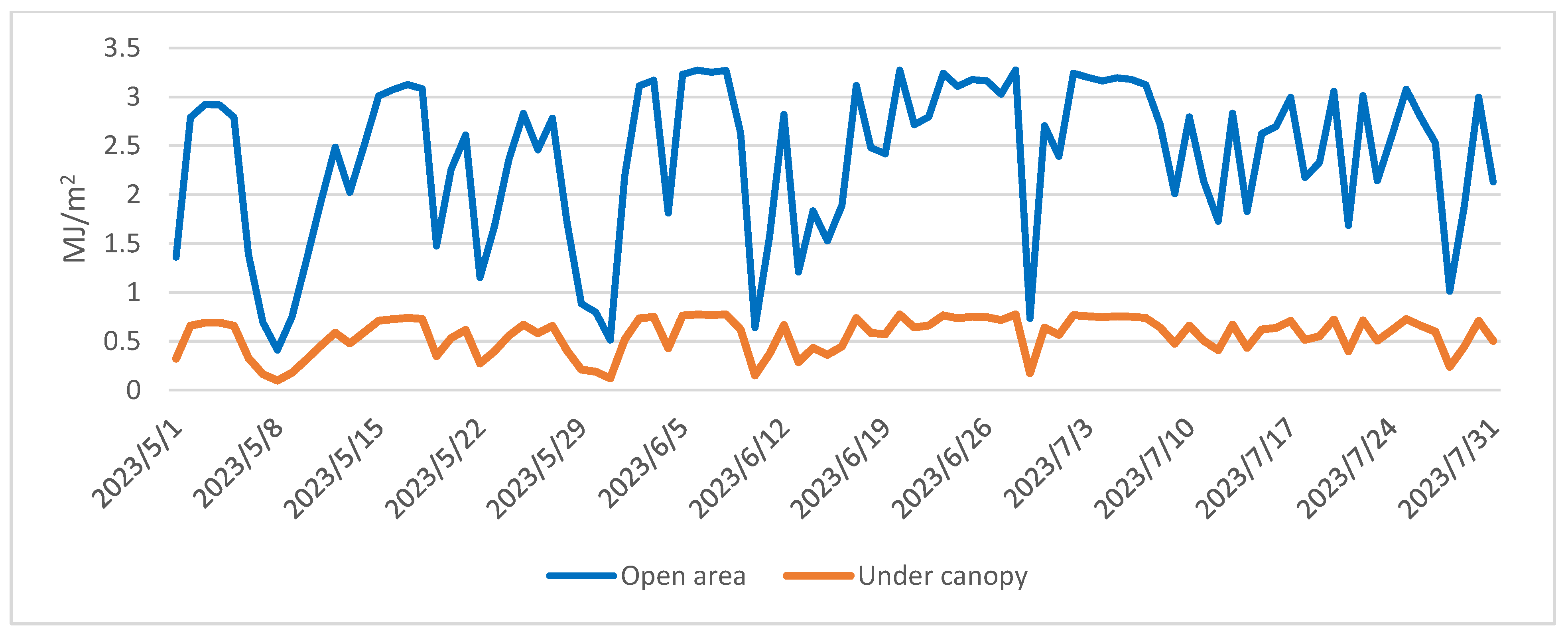

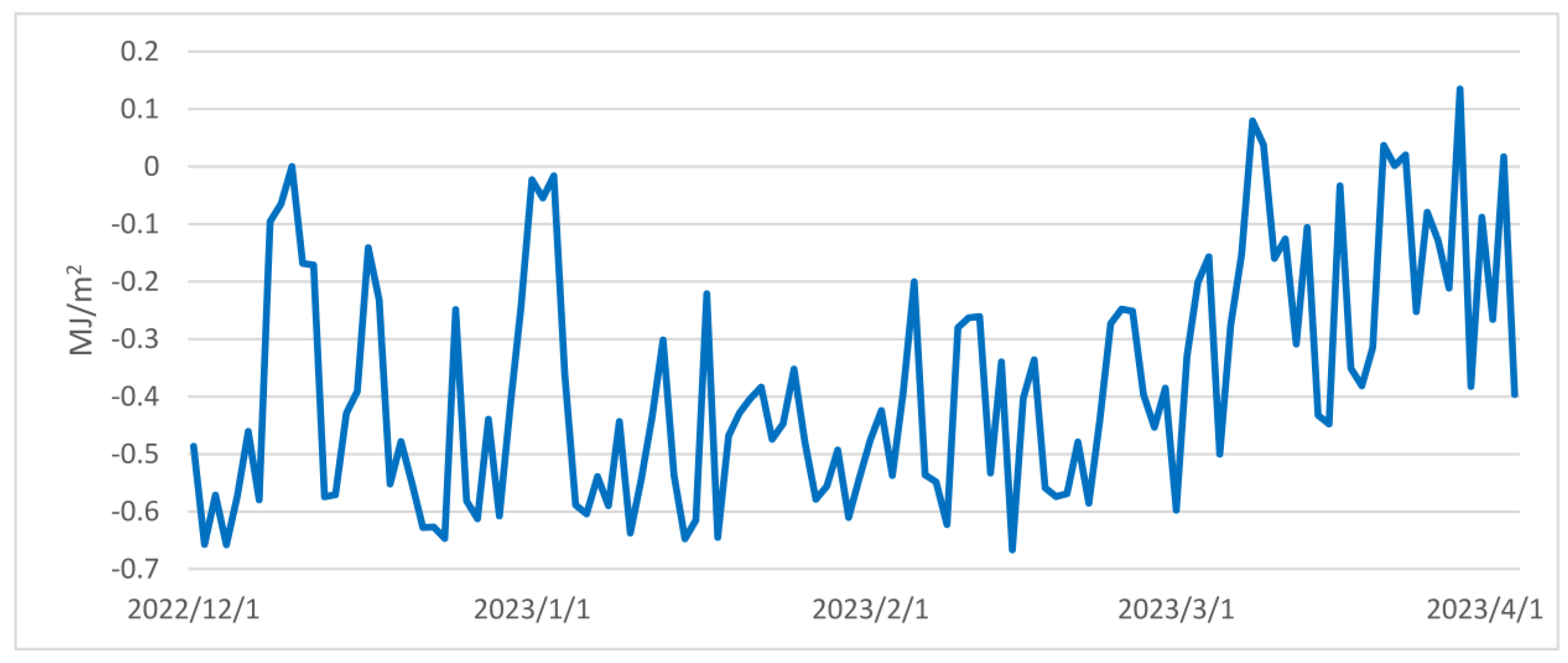
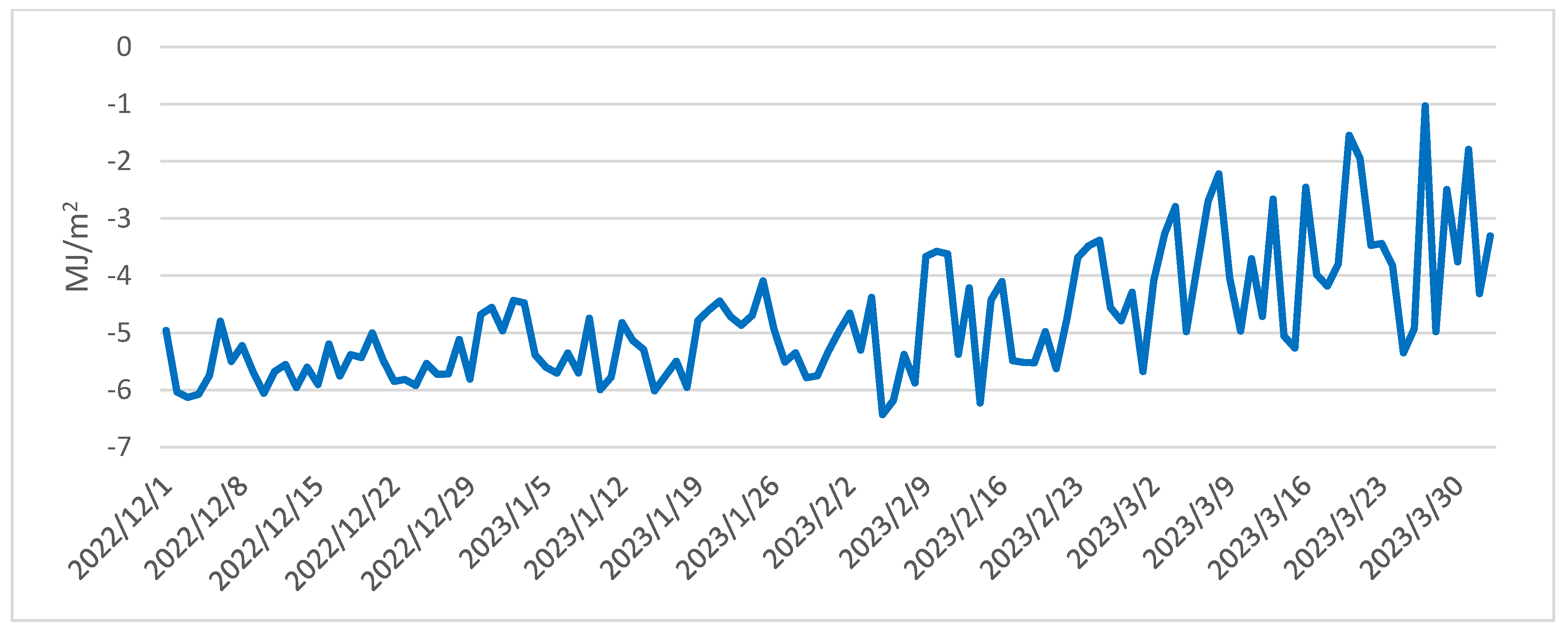
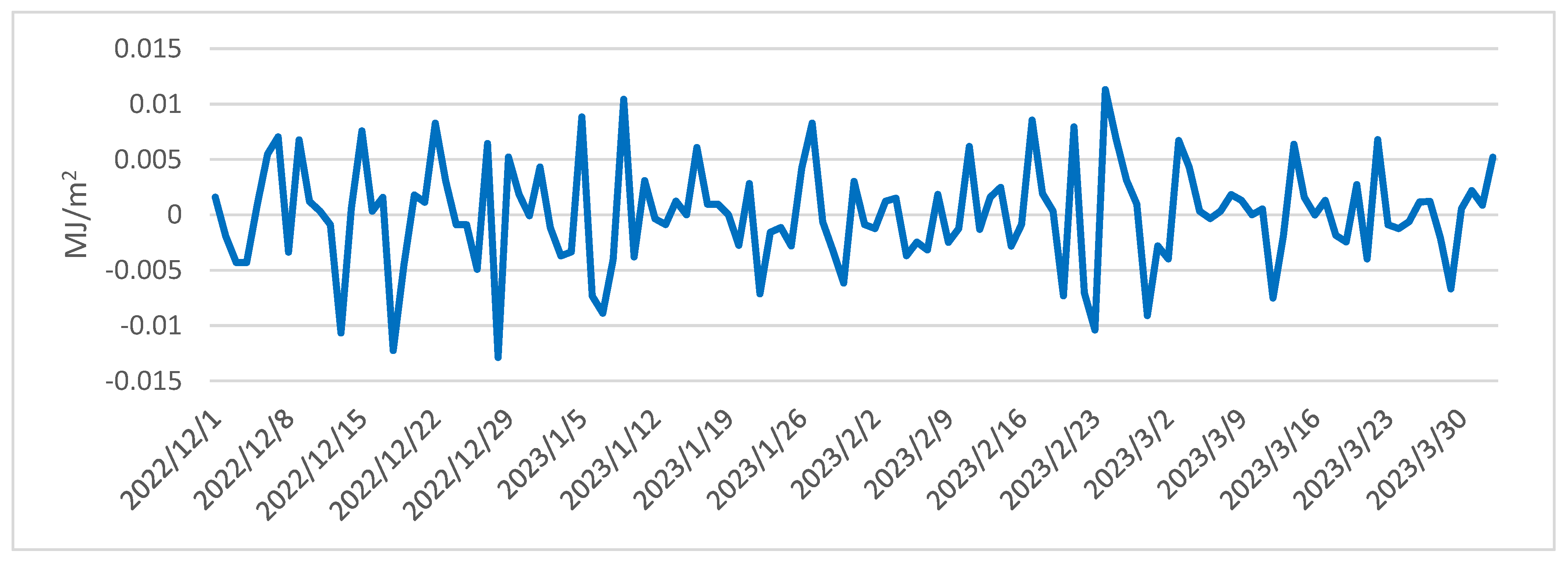
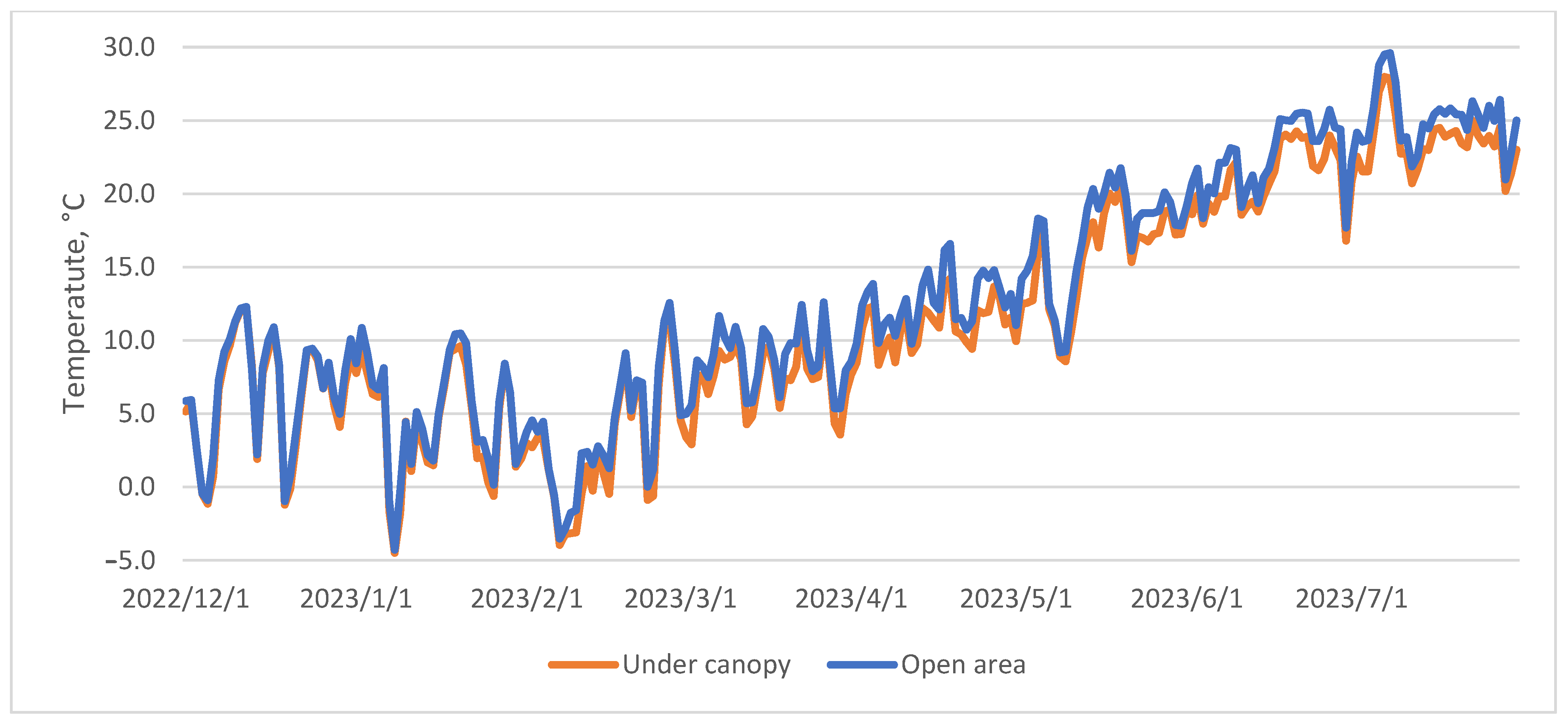

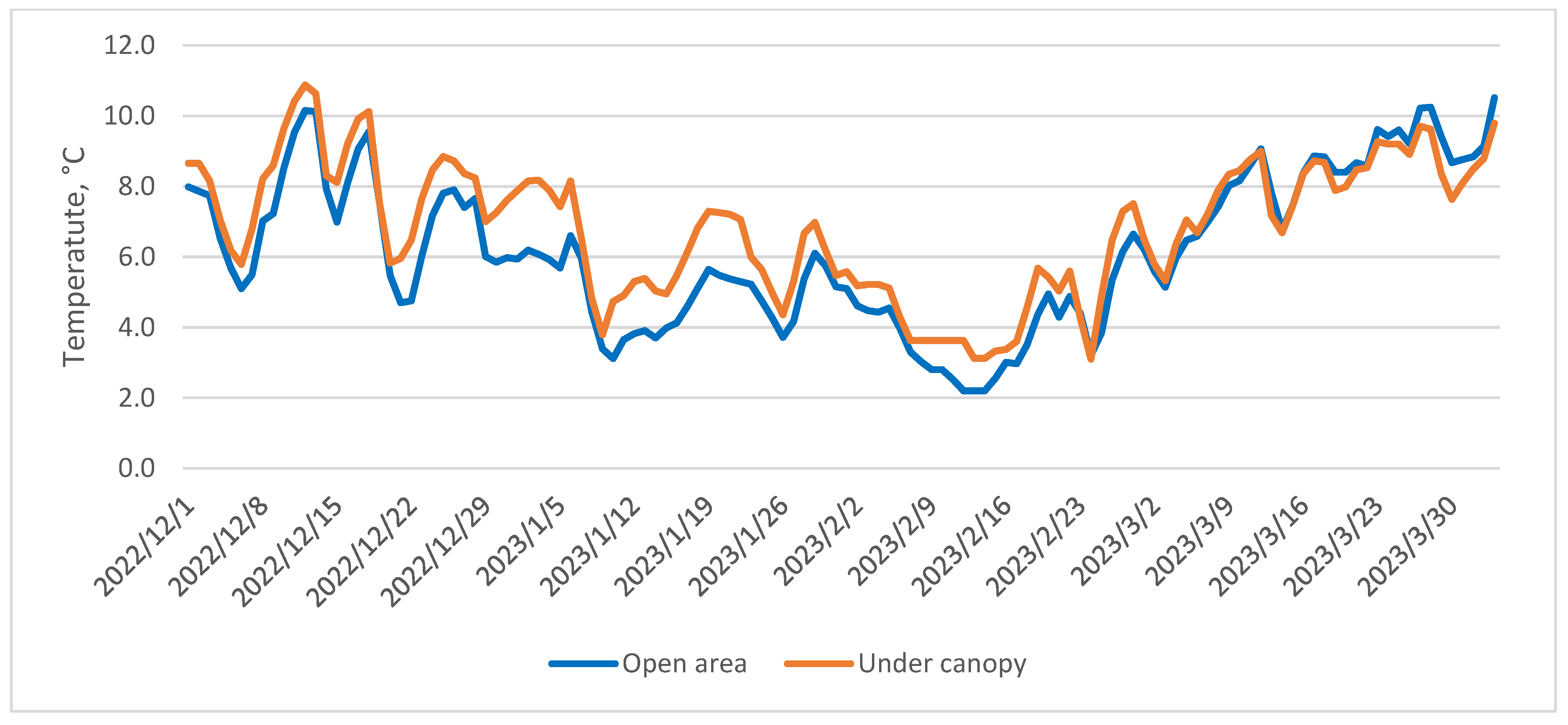

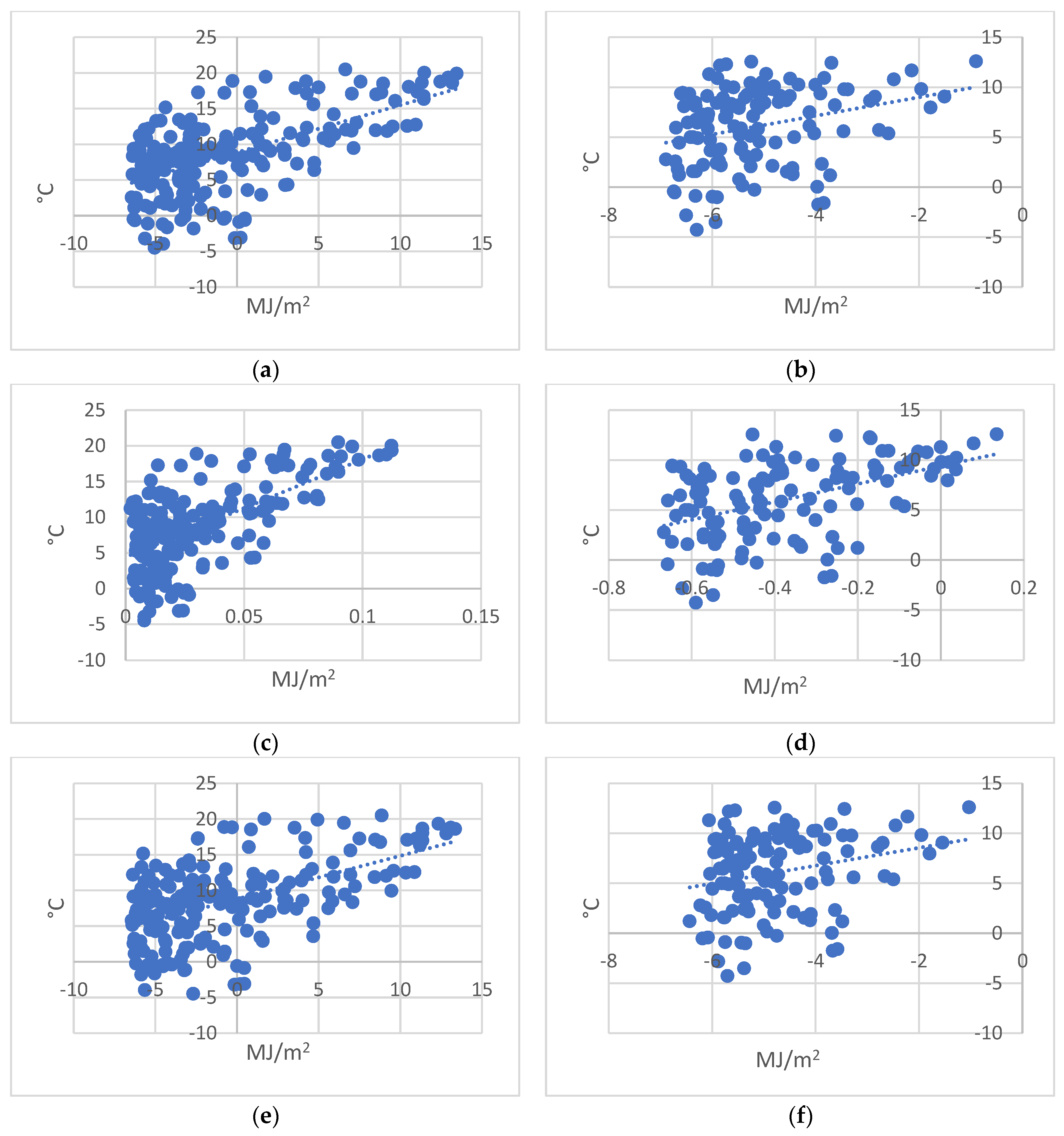

Disclaimer/Publisher’s Note: The statements, opinions and data contained in all publications are solely those of the individual author(s) and contributor(s) and not of MDPI and/or the editor(s). MDPI and/or the editor(s) disclaim responsibility for any injury to people or property resulting from any ideas, methods, instructions or products referred to in the content. |
© 2023 by the authors. Licensee MDPI, Basel, Switzerland. This article is an open access article distributed under the terms and conditions of the Creative Commons Attribution (CC BY) license (https://creativecommons.org/licenses/by/4.0/).
Share and Cite
Safonova, M.; Tabunshchik, V.; Gorbunov, R.; Gorbunova, T. Heat Budget of Sub-Mediterranean Downy Oak Landscapes of Southeastern Crimea. Forests 2023, 14, 1927. https://doi.org/10.3390/f14101927
Safonova M, Tabunshchik V, Gorbunov R, Gorbunova T. Heat Budget of Sub-Mediterranean Downy Oak Landscapes of Southeastern Crimea. Forests. 2023; 14(10):1927. https://doi.org/10.3390/f14101927
Chicago/Turabian StyleSafonova, Mariia, Vladimir Tabunshchik, Roman Gorbunov, and Tatiana Gorbunova. 2023. "Heat Budget of Sub-Mediterranean Downy Oak Landscapes of Southeastern Crimea" Forests 14, no. 10: 1927. https://doi.org/10.3390/f14101927







